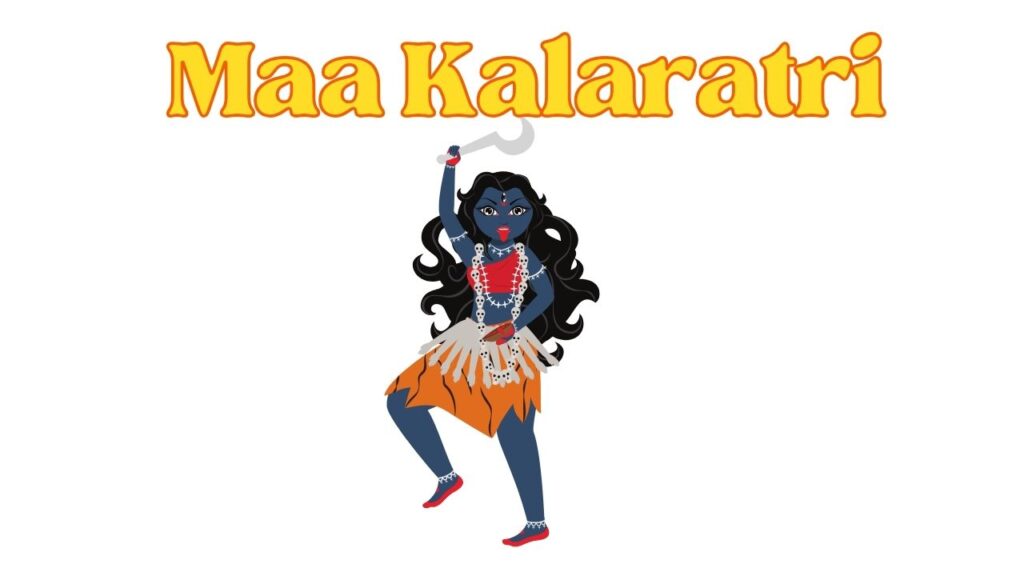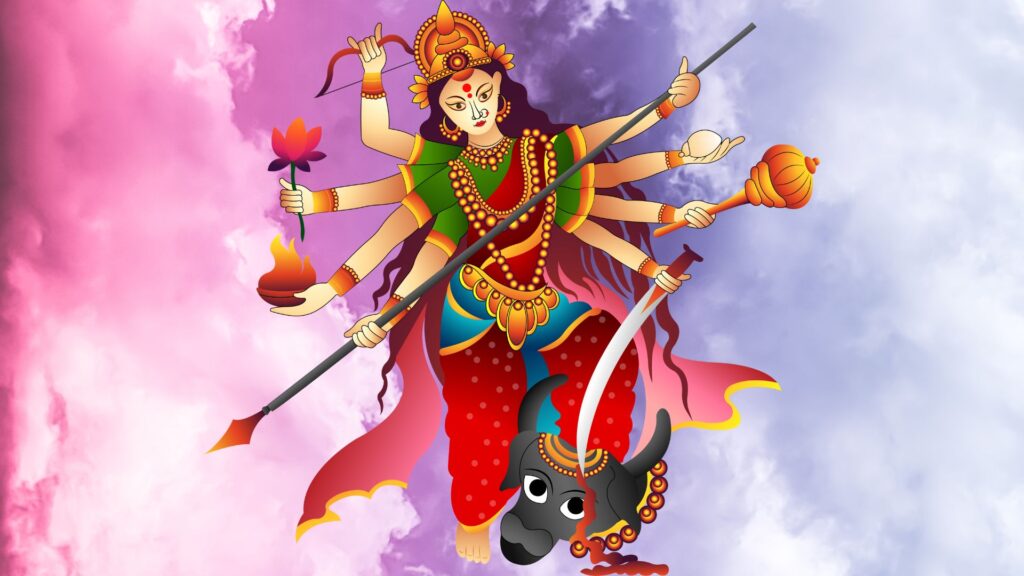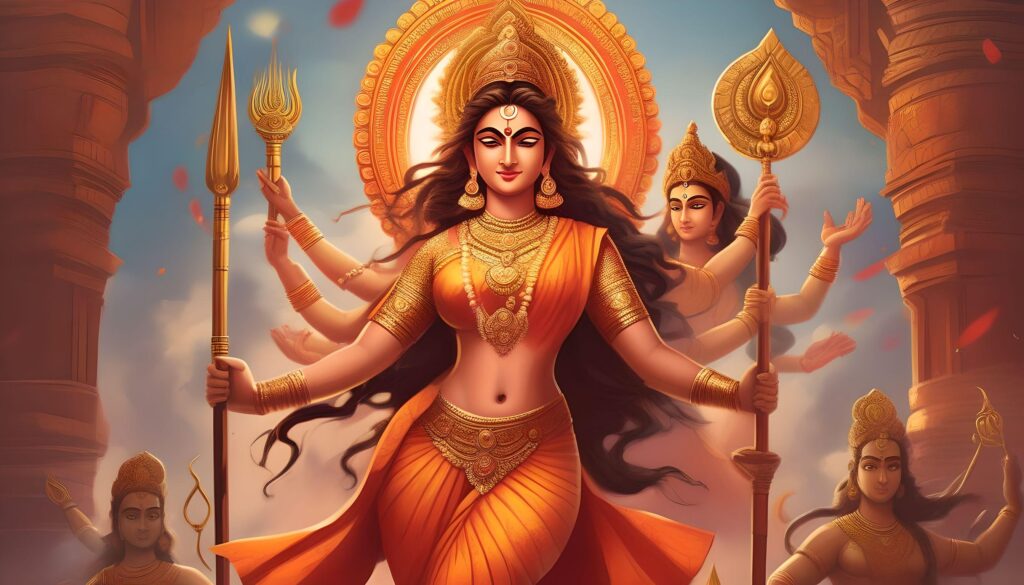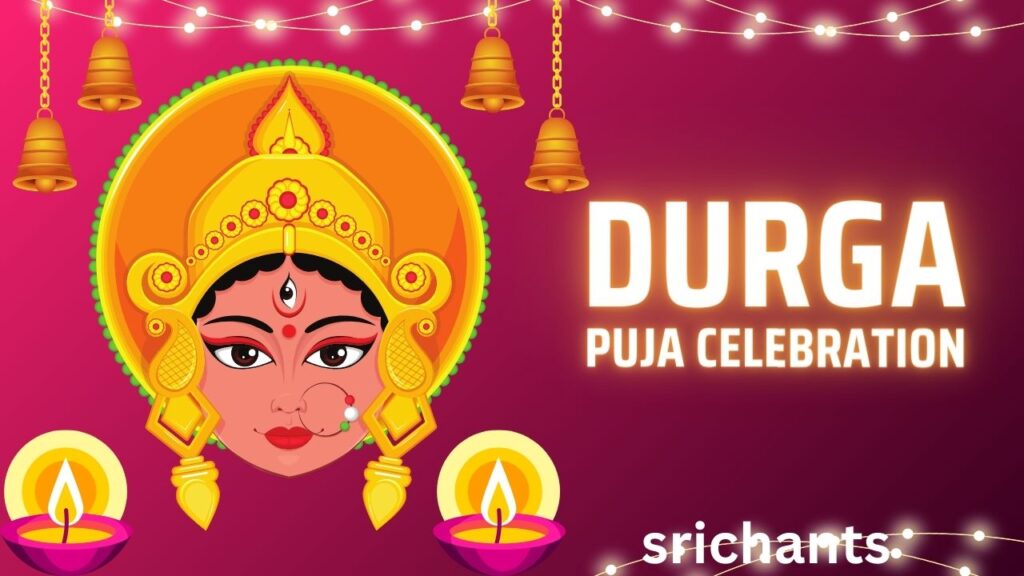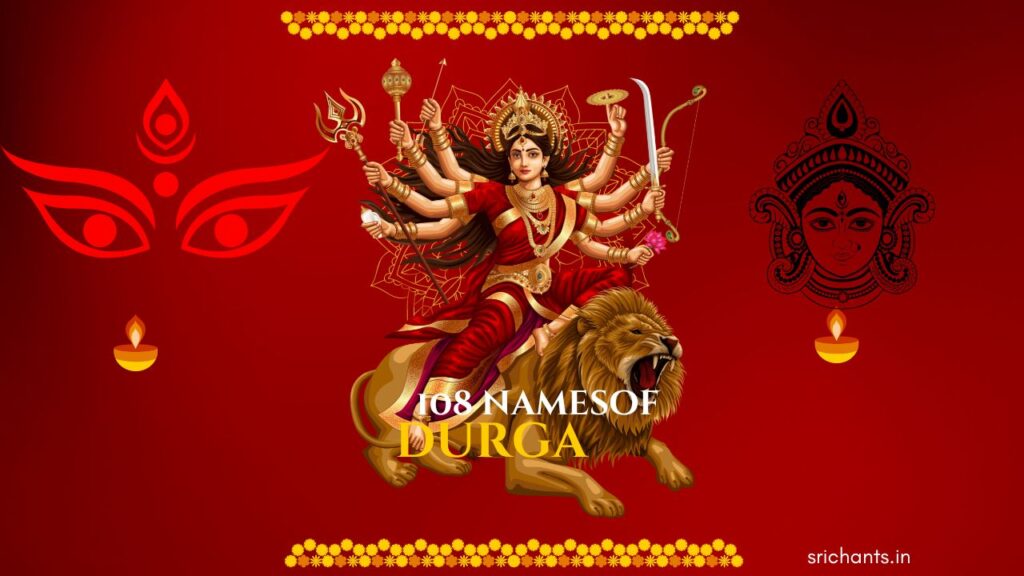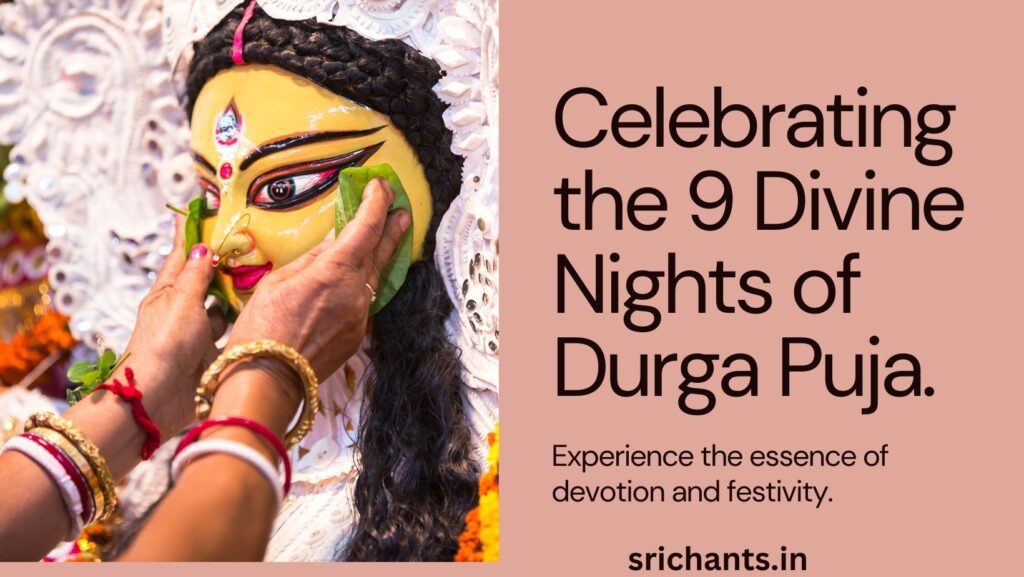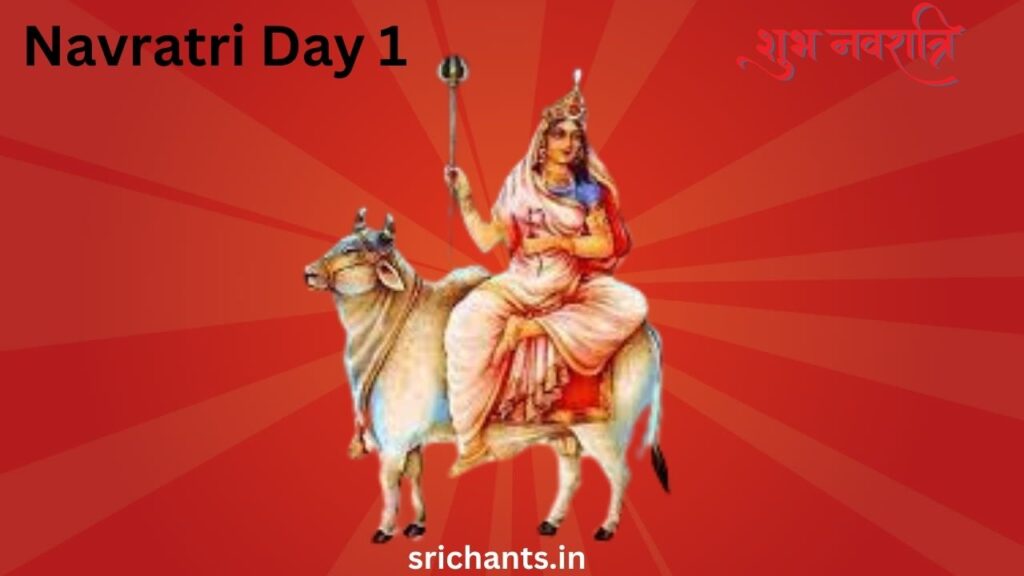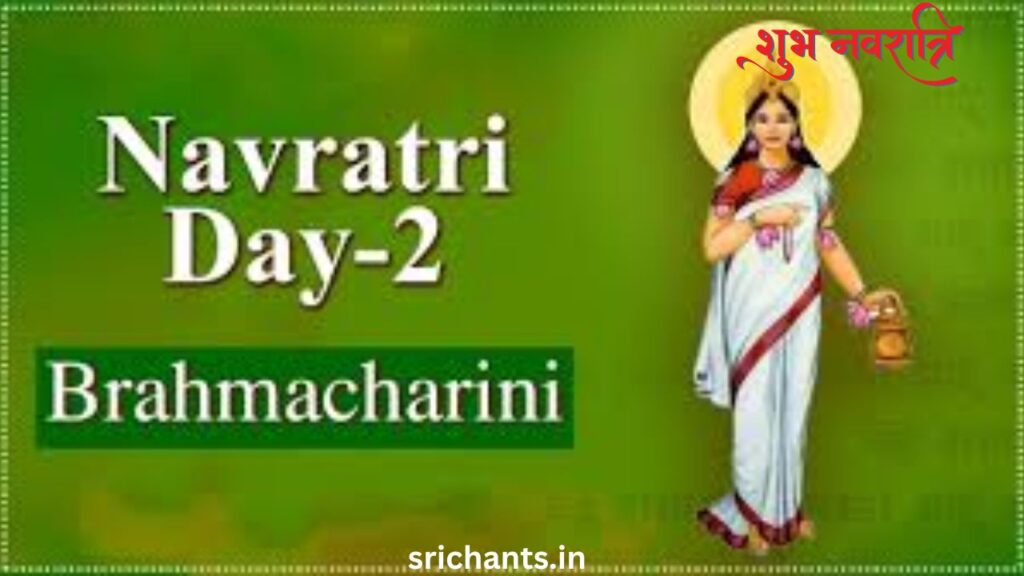Navratri Day 7 : Maa Kalaratri: Navigating Life’s Challenges
Introduction
The seventh manifestation of the Divine Mother, the ferocious and formidable Maa Kalaratri, is the focus of reverence among devotees throughout India as the nine-day celebration of Navratri reaches its pinnacle. This auspicious day, which is commemorated by the Saptami Tithi, is dedicated to the veneration of the embodiment of Goddess Durga’s most powerful and destructive form.
Maa Kalaratri’s ferocious iconography and dark complexion reflect her role as the vanquisher of evil, the remover of obstacles, and the guide through the darkest of times. As we explore the rituals and significance of this revered avatar, we discover the profound lessons she imparts to contemporary Hindus, including the conquest of inner darkness, fortitude, and transformation.
The Fierce and Formidable Maa Kalaratri
Maa Kalaratri is the seventh of the nine manifestations of Goddess Durga, known as the Navadurga, that are worshipped during the Navratri festival. Her name, which translates to “the one who is as dark as night,” is indicative of her intense and commanding demeanor. Maa Kalaratri is a striking and awe-inspiring embodiment of the divine feminine, characterized by a dark complexion, wild and untamed hair, and a garland of human skulls.
She possesses a sword, a shield, a trident, and a noose in each of her four limbs, which serve as symbols of her capacity to thwart evil, safeguard her followers, and provide guidance in the face of the most difficult circumstances. Maa Kalaratri is the embodiment of raw power, determination, and the unwavering resolve to confront and vanquish darkness in all its forms, as she rides a fierce donkey.
The Ruling Planet: Rahu and the Transformative Power of Maa Kalaratri
The enigmatic Rahu, the shadowy North Lunar Node in Vedic astrology, is the governing celestial body of Maa Kalaratri. Rahu is linked to the capacity to confront the unforeseen, as well as transformation and change. Maa Kalaratri is the deity who guides her devotees through the darkest of personal and spiritual challenges, much like Rahu represents the shadows and the mysterious aspects of the cosmos.
Maa Kalaratri embodies the ability to confront life’s obstacles head-on, transforming adversity into fortitude and wisdom, under the influence of Rahu. She instructs her disciples to adopt a fearless attitude, confront their fears, and emerge from the shadows of doubt and despair as more resilient, stronger individuals.
The Conquest of Darkness and the Triumph of Light
In both the external world and the souls and minds of her devotees, Maa Kalaratri’s primary responsibility is to vanquish the forces of evil and darkness. Her fierce iconography and dark complexion are indicative of her capacity to dispel the darkness of ignorance, avarice, and negativity, replacing it with the radiant light of spiritual enlightenment, compassion, and wisdom.
Devotees seek the courage and determination to confront and surmount the inner shadows that may be holding them back through her worship. Maa Kalaratri’s divine grace enables them to confront their demons, face their fears, and emerge victorious, which in turn provides them with a renewed sense of purpose and a more profound comprehension of the transformative power of the divine feminine.
The Significance of Maa Kalaratri in Navratri
The Hindu calendar places great importance on the seventh day of Navratri, which is dedicated to the worship of Maa Kalaratri. As the festival approaches its culmination, devotees acknowledge the significance of embracing the transformative and fierce energy of this potent avatar of the Goddess.
Maa Kalaratri’s day is commemorated on the Saptami Tithi, which is the seventh lunar day of the Shukla Paksha (bright fortnight) in the month of Ashwin. This timing is considered to be auspicious for both invoking her blessings and requesting her divine intervention in overcoming challenges and obstacles.
Rituals and Offerings for Maa Kalaratri
The rituals and offerings that are associated with the worship of Maa Kalaratri are deeply rooted in symbolism and tradition. Beginning the day with a holy bath, which symbolizes the purification of the body and spirit, devotees begin their day. Afterward, they place the idol or image of the Goddess on a clean platform, decorate it with fresh flowers, and ignite incense sticks to establish a sense of reverence and devotion.
Mantras that are dedicated to Maa Kalaratri, including the potent “Om Devi Kalaratryai Namah” mantra, are chanted during the puja ceremony. A special bhog, or prasad, is presented by devotees as a symbol of gratitude and reverence. This bhog may consist of fruits, candies, and other exquisite offerings.
The Symbolic Significance of Maa Kalaratri’s Iconography
Maa Kalaratri’s iconography is replete with symbolic significance, with each element symbolizing a more profound aspect of her divine power and the lessons she conveys to her devotees.
For example, her dark complexion symbolizes the triumph of enlightenment and the annihilation of ignorance. The divine feminine’s raw, unrestrained force and unbridled energy are symbolized by the chaotic and untamed hair. Her mastery of the cycle of life and death, her capacity to transcend the material world, and her guidance of her followers toward spiritual liberation are all symbolized by the garland of human skulls.
The sword, shield, trident, and lasso she wields symbolize her ability to vanquish evil, safeguard her followers, and guide them through the most difficult of circumstances. Maa Kalaratri’s mount, the formidable donkey, symbolizes her capacity to transverse the most perilous of terrains and surmount any impediment that impedes her progress.
The Boons of Maa Kalaratri’s Worship
Maa Kalaratri devotees who venerate her with unwavering faith and devotion are believed to receive a plethora of divine interventions and blessings. The most significant of these is the reduction of the malevolent effects of the planet Shani (Saturn) in one’s horoscope.
The negative influences of Shani, a planet frequently associated with difficulties, delays, and obstacles, are purportedly neutralized by the fierce and transformative energy of Maa Kalaratri. Devotees endeavor to surmount the obstacles and adversities that may be obstructing their lives by invokeing her benediction, thereby establishing a more prosperous and optimistic future.
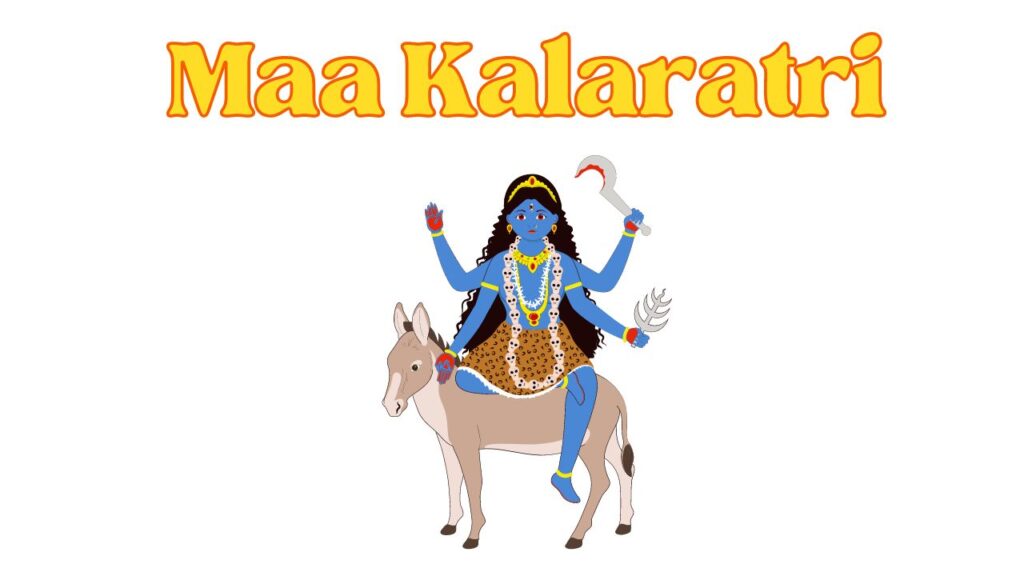
Maa Kalaratri and the Conquest of Inner Darkness
Maa Kalaratri is also admired for her capacity to assist her followers in the overcoming of their own inner darkness, in addition to her function as the conqueror of external evil. She is a symbol of the ability to confront and surmount the shadows of dread, doubt, and negativity that may be present in the human psyche.
Devotees are encouraged to confront their inner demons, confront their innermost fears, and emerge as more resilient, stronger individuals through her worship. Maa Kalaratri’s unwavering and fierce energy functions as a beacon of hope, motivating her followers to access their own reserves of spiritual strength, determination, and courage.
The Lessons of Maa Kalaratri for the Modern Hindu
The lessons taught by Maa Kalaratri are of great significance to the modern Hindu in the fast-paced, ever-changing landscape of the modern world. Her teachings on the conquest of interior darkness, transformation, and fearlessness serve as a guiding light for those who are navigating the challenges of the 21st century.
Maa Kalaratri’s unwavering resolve and her capacity to confront and vanquish evil serve as an inspiration to her followers to confront life’s challenges with a comparable level of resilience and determination. Her divine grace enables them to embrace change, adapt to the constantly changing demands of the modern era, and arise from the shadows of adversity as more enlightened, stronger individuals.
Maa Kalaratri and the Pursuit of Spiritual Enlightenment
The worship of Maa Kalaratri is the key to accessing the deepest realms of the divine for the spiritual seeker. Her connection to the enigmatic Rahu, the Lunar Node, is indicative of her capacity to lead her followers through the unexplored realms of the spiritual domain.
Maa Kalaratri is revered by yogis and tantric practitioners as the embodiment of the divine feminine energy, the Shakti, which has the capacity to activate the crown chakra and grant the ultimate state of spiritual enlightenment. They aspire to transcend the constraints of the material world and achieve the utmost levels of consciousness by worshiping her, thereby aligning themselves with the cosmic forces that govern the universe.
The Enduring Legacy of Maa Kalaratri
The worship of Maa Kalaratri serves as a testament to the divine feminine’s enduring power and relevance in the Hindu tradition as the Navratri festival approaches its climax. A timeless symbol of the triumph of good over evil, light over darkness, and the indomitable spirit of the human soul, her forceful and transformative energy continues to inspire and empower devotees across generations.
Modern Hindus are reminded of the significance of embracing fearlessness, confronting their inner demons, and harnessing the transformative power of the divine through the veneration of Maa Kalaratri in order to forge a path towards spiritual enlightenment and personal development. The lessons of Maa Kalaratri will continue to resonate as the Navratri celebrations draw to a close, guiding her devotees on their eternal journey of self-discovery and the pursuit of the transcendent.
#navratriday7 #day7navratrigoddess #navaratriday7 #katyayani #katyayanidevi #maakatyayani #katyayanimata #devikatyayani
